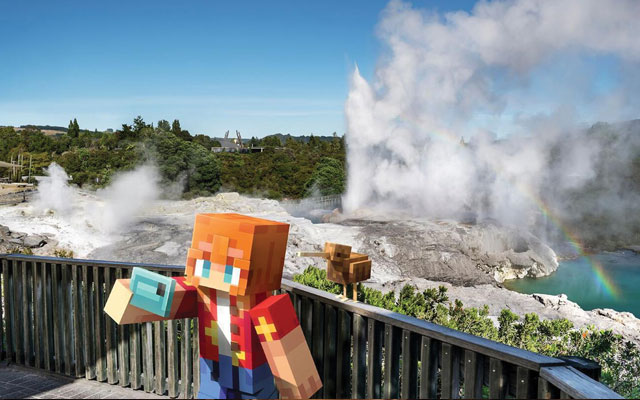Destination marketers are riding on the influential power of popular games, addictive films, celebrated musicians and more, to inspire travel dreams and convert interest into bookings
Singapore sights and locations have been trending high on social media across May and June, riding on the massive global fanbase of two members from Korean boyband BTS.
Released on May 16, a three-minute, 25-second music video for Jin’s English song, Don’t Say You Love Me, the main track off his second solo album Echo, which was also released on the same day, shows the popular artist and his love interest, an established South Korean actress Shin Se-kyung, interacting around eight landmarks in Singapore.

Besides well-known tourist locations like National Gallery and Gardens by the Bay, the music video also featured locations that are relatively less prominent, but no less unique in their own way – the rooftop carpark of Goldhill Plaza, which is known for its unique circular design; Emerald Hill at night, which is home to a cluster of preserved Chinese Baroque shophouses; and Keng Eng Kee Seafood, a local restaurant listed in the Michelin Guide.
In just five days, the Don’t Say You Love Me music video has acquired 10 million views on YouTube as of the evening of May 21. At press time on June 19, viewership crossed the 19-million mark.
Fellow BTS member, J-Hope, who did two sell-out solo concerts in Singapore April 26 and 27, also put Singapore sights in the spotlight when he posted an Instagram Reel of himself enjoying Singapore Botanic Gardens, Sentosa Sensoryscape, Alkaff Bridge, and digging into a popular local breakfast of half-boiled eggs and kaya toasts at Ya Kun Kaya Toast and an elaborate dish at one-Michelin-starred Waku Ghin. The itinerary, part of his world tour stop in Singapore, was created in collaboration with STB.
The Reel on J-Hope’s official Instagram page has 29.5 million views and 101,000 shares at press time.
Commenting on Jin’s music video collaboration, Serene Tan, executive director – North Asia, Singapore Tourism Board (STB), said it was a “unique opportunity to showcase Singapore’s culture, nature, and architecture through a charming blend with Jin’s music”.
“We hope that people around the world will come to see and experience Singapore from a new perspective through the music video,” Tan added.
Singapore is not the only destination that has chosen to make its marketing campaign ‘pop’ with the power of global influencers.
More than 8,000km away, the marketing gurus at Tourism New Zealand (TNZ) recently jumped on the Minecraft bandwagon and launched the world’s first fully playable destination New Zealand in the game world.
In collaboration with Warner Bros Pictures and Mojang Studios as well as 11 mana whenua indigenous Maori groups and the tourism industry, TNZ created a destination DLC (downloadable content) for Minecraft that features six local locations, including Waitomo Caves (Waikato), Rotorua (Bay of Plenty), Kapiti Island (Wellington), Abel Tasman (Nelson/Tasman), Tekapo (Mackenzie), and Doubtful Sound (Fiordland). Game players and potential visitors are invited to experience a range of real-world activities in the DLC, such as paddling a waka in Abel Tasman, exploring glow-worm caves in Waitomo, or stargazing in Tekapo.
The DLC was launched alongside the April release of A Minecraft Movie, starring Jason Momoa and Jack Black, and filmed in New Zealand.
With widespread appeal and over 300 million copies sold, Minecraft is the best-selling video game of all time. The partnership enables TNZ to connect with 70 per cent of its primary target audience in key markets who actively engage with Minecraft, making it a powerful tool for global engagement.
TNZ chief executive René de Monchy, expects this activity to attracting NZ$50 million (US$29.7 million) in visitor spend this year and generate NZ$50 million in equivalent advertising value via media and social media exposure.
These headline-grabbing destination marketing collaborations follow on the heels of another pop culture effect. The third season of the popular HBO series, The White Lotus, which was filmed in Thailand, drove tourism interest and arrivals.
Not only did the Tourism Authority of Thailand produce a dedicated film microsite to offer visitors a virtual journey through Koh Samui, Phuket, and Bangkok, which were featured in the series, it also partnered fashion label 3.1 Phillip Lim to launch a limited edition collection of outfits and accessories that are said to be “ideal for visiting Thailand’s vibrant temples, walking through the country’s infamous night markets, or simply looking effortlessly while exploring its bustling streets and serene landscapes”.

Business realisation
It is one thing to boost a destination’s reputation and inspire travel through pop culture, and another to convert ideas into actual tourism business.
TNZ’s Minecraft campaign is certainly more than a marketing gimmick – it boasts business conversion power, enabled by an integration of bookable Minecraft-inspired itineraries with travel agent partners. Klook has integrated Minecraft products into its Klook NZ Pass while Trip.com is promoting Minecraft-inspired itineraries.
Gregg Wafelbakker, general manager Asia with TNZ, told TTG Asia: “Often, when we achieve earned media to build awareness for New Zealand, it is difficult to convert attention into actual bookings. So, we built bookable itineraries that feature some of those iconic experiences in the DLC.”
The DLC initiative also leverages the reach of travel and tourism KOLs, who have been invited to play the game and then immerse in real-life versions of the activities across New Zealand.
“Our work with Minecraft does not just target gamers. The campaign reaches beyond gamers through lifestyle influencers. Minecraft was just the hook,” stated Wafelbakker.
STB has leveraged other celebrities in its destination marketing efforts, such as Coldplay and Charlie Puth. To maximise the business impact of such destination exposures, STB promotes content on its official social media platforms to sustain interest and encourage travel.
Tan added: “Featuring Singapore in content by global celebrities helps drive travel consideration by tapping into the set-jetting trend, where fans are inspired to visit locations associated with their favourite artists. Also, by showcasing behind-the-scenes content, travel tips, and suggested itineraries of artists, we help turn destination inspiration into actionable plans.”
Banking on attention around The White Lotus series, private sector tourism players in Thailand swiftly rolled out film-inspired holiday packages for fans.
Three Anantara resorts, which were used as film locations, came together to offer series fans the Lotus Awakening Escape package for stays at Anantara Lawana Koh Samui Resort, Anantara Mai Khao Phuket Villas, and Anantara Bophut Koh Samui Resort.
Banyan Tree Samui introduced Sense of the Sea, a custom-built speedboat offering private charters and day trips to nearby islands, including film locations. According to general manager Remko Kroesen, there has been a marked increase in interest to visit the marine destinations featuring in the show via these speedboat tours.
“We are constantly being asked about the film locations, especially the stunning islets, white beaches and sapphire waters of Mu Ang Thong Marine Park, which is possibly the epitome of paradise. Our Sense of the Sea tour takes in all of that scenery and visitors generally find it an awe-inspiring experience,” said Kroesen.

Set-jetting reach
Lavinia Rajaram, Asia travel expert and director of public relations at Expedia Group, recalled the influential power of an earlier season of The White Lotus.
When The White Lotus season 2 went on screens in October 2022, Expedia recorded a 300 per cent increase in searches all over the world for San Domenico Palace, Taormina, A Four Seasons Hotel and Sicily, where the series was set and filmed.
A “similar frenzy” for Thailand was expected with season 3. As soon as Koh Samui was announced in January 2024 as the film location for the latest season set for a February 2025 premiere, Expedia saw searches for the resort destination shoot up 80 per cent. Searches for neighbouring Thai destinations, like Bangkok and Phuket, also spiked.
While films have always shaped travel dreams, Rajaram said their influence has expanded on the back of governments and tourism authorities becoming more strategic about their use of such media content to achieve tourism goals. Furthermore, social media has enabled a wider and stronger push of films and related content across the world.
Expedia identified the set-jetting trend in 2022, and travellers’ desire to visit the locations featured in their favourite dramas and movies has continued to grow 16 per cent year-on-year.
“In our research, two-thirds of travellers say movies, streaming services and TV shows have influenced their travel choices,” Rajaram added.
Concert power
Concerts have also played a key role in boosting destination reputation and tourism earnings.
Since reopening to international tourism, Macau has hosted a range of concerts that contribute to the city’s live events scene. Integrated resorts compete on star power, from Andy Lau to Andrea Bocelli.
The concert economy is now one of the key pillars supporting the diversification of Macau’s tourism offerings. Macau’s 240 concerts throughout 2023 brought in around 1.1 billion patacas (US$137 million) in ticket sales.
Pamela Chan, managing director of Taipa Village Destination, said concerts are contributing to a thriving Macau. She observes that concerts are bringing a “strong influx of visitors” to Macau and ringing the tills for retailers, restaurant operators, and small businesses in the community.
She shared that some local businesses in Taipa Village are creative with maximising star power when they descend on Macau. Some would organise fans gatherings, using shop entrances and props to entice photo opportunities and drive up merchandise sales.
Pull factor
Of all the vehicles of pop culture, which has a stronger pull factor?
Rajaram believes that each of them – games, films, music videos, concerts and event sports events – “have their own pull power in travel and tourism, and each engages with a different demographic of travellers”.
However, she believes that concerts tend to materialise short trips, as concert-goers visit mainly for the performance while TV tourism has the potential to encourage longer stays, as fans not only visit film locations but also book activities and hotels where their idols had done, visited or stayed at.
Kroesen also sees strong and lasting power from film placements. He said: “We can assume that many viewers will watch the show at a later date, and that bodes well for later in the year when vacationers look to escape the winter months in Europe and the US.
“However, it is worth pointing out that for many years both the local people of Koh Samui and the Thai tourism authorities have worked together successfully to implement a long-term goal of developing Koh Samui as a luxury sustainable island-destination. A decade ago, this might have been seen as over-ambitious, but the reality is that it is coming to fruition now. I am confident that Koh Samui tourism will continue to flourish in this way in the coming years, well after The White Lotus effect has worn off.”











